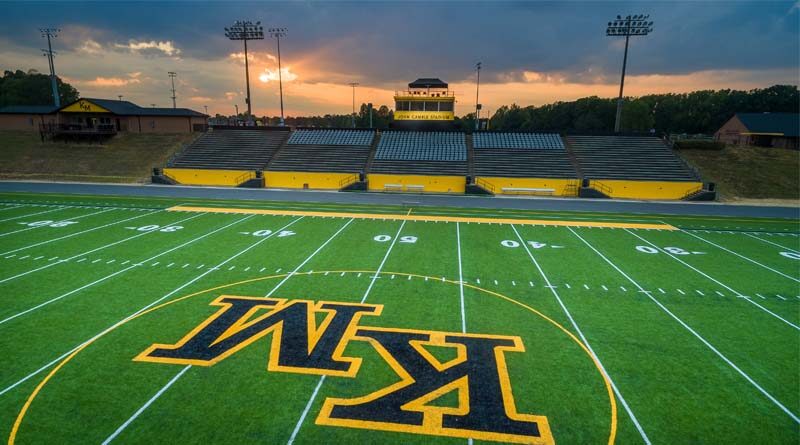Five Questions to Ask Before Selecting Your Synthetic Turf
By Colin Veditz
Synthetic turf continues to be an increasingly popular choice for educational facilities looking for more durable and playable fields. Currently, there are between 12,000 and 13,000 synthetic turf sports fields in the U.S., and the Synthetic Turf Council estimates there are 1,200 – 1,500 new installations each year.
Synthetic turf first emerged in the 1960s. Then, in the 1980s, we saw an improved second generation product crop up. The 90s brought a new infilled system that mimicked the look, feel and playability of real grass, and is the foundation for all turf systems today.
Modern systems enhance playability, safety and the field’s overall appearance, making them a popular option for the toughest sports, including football, soccer and lacrosse.
With countless options from which to choose, it is important to point out that not all turf systems are created equal.
Pick the wrong synthetic turf for your facility, and you could be left with a field of nothing but sand and rubber in just a few years.
Choose wisely, and you’ll enjoy a turf that stays in great shape and provides a consistent and safe playing surface for your school’s athletes.
So, whether you are building a high school multisport field or a university soccer pitch, asking these questions while shopping for a new field will help you make the right decision on your facility’s turf system:
What type of fibers are used in the turf?
You want a turf that will last a long time, so thicker and wider fibers are preferable. Many turf products are made solely with thin monofilament fibers – popular because the blades look more like grass.
However, monofilament fibers more easily split and pull out, requiring more maintenance time (and additional, tedious time spent sweeping up fibers). Lose a substantial number of fibers, and you’ll soon be playing on nothing but infill, the substance put in between blades to make the field springy, keep blades upright and help with drainage.
So, make sure you choose a high quality product that has undergone rigorous testing. And look for fibers that are interlocked to prevent fiber loss and breakage.
Remember: thicker and wider is always better (the thinner the fiber, the weaker it is).
How are the fibers integrated with the turf?
You’ll want to ask the turf manufacturer if the fibers are glued into a backing – glued-in fibers pull out more easily – or if they are actually woven to become interlocked together, creating one solid piece.
Note that a tufted product with a woven backing is still a tufted product (so be sure to ask if the turf is truly woven).
How long is the turf’s warranty?
The length of the warranty speaks to the product’s durability. Eight-year warranties are the industry standard (a 10-year warranty is the “gold” standard).
Also, pay attention to the fine print, since many manufacturers offer prorated warranties. A prorated warranty loses value, giving you a fraction of the coverage, as time passes.
How will the turf’s construction enhance safety?
The full turf system (the turf, shock pad and infill) ensures you have the safest field possible.
The shock pad and infill protect players from impacts, and the turf provides traction while supporting the infill. With tufted turf, the fibers are glued in rows, resulting in “valleys” where infill can easily shift around and become displaced, leaving “bald” areas with little infill and less protection for players. With woven turf, the interlocked fibers keep infill in place, creating a consistent surface.
For increased safety, the shock pad is your best insurance policy; it guarantees there is always something to protect the player on impact.
What’s it like to play on the turf?
When it comes to a turf’s playability, a consistent surface is key; it will play more like natural grass and improves running and athlete agility. If your turf system’s infill is constantly shifting around, that will negatively affect player performance and discourage natural ball roll and bounce.
When selecting your turf, take the time to ask the right questions. Choose carefully: it can be the difference between a field that performs and looks great over the years and a lumpy, gray, dangerous surface. In the right hands, though, your synthetic turf field can be part of your facility’s legacy — to be enjoyed for years to come.
Colin Veditz is the installation quality control manager at TenCate, a global leader in the development, production and marketing of synthetic turf components and the design of synthetic turf systems for sports fields.

